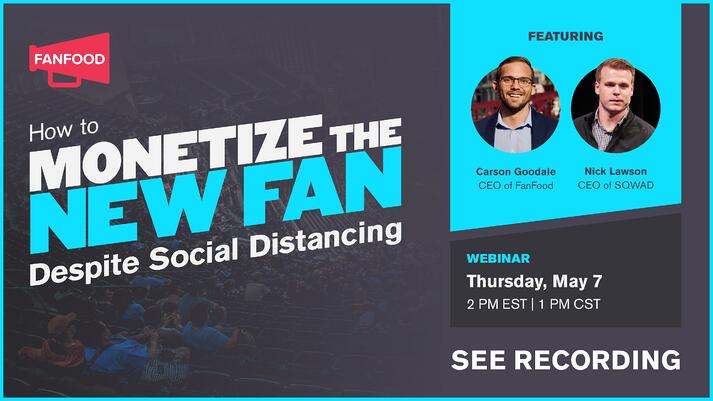How to Monetize the “New Fan” Despite Social Distancing: A Livestream
Last Thursday we concluded our livestream on the topic of “How to monetize the New Fan despite social distancing”, hosted by Carson Goodale, CEO of FanFood and Nick Lawson, CEO of SQWAD. Due to social distancing (both as guidelines and a new consumer mindset), it’s very likely that capacity and turnout would drop post lockdown. How should venues and businesses creatively generate revenue and offset potential revenue loss? If you’d like to see a full recording of the webinar, please visit https://fanfood.app/NewFanRecording

How will fans feel about returning to sports and other live events?
To find out, FanFood conducted a survey of nearly 1,000 consumers nationwide, and what they say speaks volumes about how businesses should prepare. We call the post-lockdown fans the “New Fan”: fans who think, feel and act differently due to the permanent mindset shift during the pandemic. You can find a full report on the survey findings here.1. The New Fan still wants to attend live events, but is likely to be much more cautious about safety and hygiene.
55.85% surveyed answered they will “very likely” attend sports games, and 26.21% answered “likely”. However, there are still 8.27% of the fans sitting on the fence, and nearly 10% saying “unlikely” or “very unlikely”. Another survey conducted by ESPN however, showed that 72% of Americans wouldn’t attend sports events if a vaccine hasn’t been found. Interestingly enough, history repeats itself. From 1918 to 1919, the Spanish Flu outbreak ravaged the world, killing more than 675,000 in the U.S. alone. Despite the threat of the flu, fans still turned up at sports games. This photo at a 1918 Georgia Tech home game was taken by a student, Thomas Carter, who graduated in the 1920s. It’s clear that the vast majority of the spectators in the photo were wearing masks in what published reports said was the peak of the flu in October and November. While it’s difficult to know exactly what percentage of people will feel comfortable attending live events, one thing is certain: they will be very cautious about hygiene and safety, as indicated by 86.6% of those surveyed.
2. Fans will still order concessions, but will more likely to do so if in-venue mobile ordering is an option.
The good news is that coronavirus hasn’t entirely deterred people from ordering and eating food in public. While 12.21% of fans indicated that they would not order concessions at all, the majority of fans (62.06%) said they will still be willing to order and eat during the game. However, people are definitely looking for other options. For example, 10.31% of fans said they will order concessions and eat ahead of the game (which also encouraged us to build out our Order Ahead capability within the app), and 10.94% said they will order and eat during the game only if there’s contactless pickup options available.How can venues and businesses be creative in revenue generation?
1. Digitization of sponsorship assets We’ve always been advocates for digital sponsorship assets over traditional, impression-based assets. As Nick brought up during the webinar, before COVID-19 the split between digital and traditional sponsorship assets was probably 30-70. However, that will drastically change after the pandemic. For starters, there won’t be as many people within a venue, hence the impression-based sponsorship model will no longer be attractive to advertisers. As you can see in the comparison table below, measurable, trackable assets that are conversion-oriented will be the key to driving up your sponsorship revenue. While venues and businesses can’t guarantee the number of people showing up, they can still track and report the level of engagement and conversion among those who do show up. That will be powerful proof to your advertisers that despite a smaller crowd, you can still engage them more effectively on digital platforms. Besides, digital assets are way cheaper and more flexible than printing out large banners — who doesn’t love a cost reduction? 

2. Use cashless & contactless to your advantage. Let’s face it — contactless is the new necessity. And it’s shown in our survey responses as well: over 80% of the fans will be more likely to — or even only — order concessions if mobile ordering and contactless pickup is offered. But the benefit of mobile ordering doesn’t stop there. Mobile orders are on average 25%-30% larger than walk-up orders because of how easy it is to add items to your cart on a phone. In addition, without needing to wait in lines, every other user on the FanFood platform orders more than once throughout one single game or event. If you choose to offer delivery on top of express pickup, you can expect to see your delivery orders roughly 70% larger than pickup orders. 

3. Changing times demand a shift in mindset towards collaboration. Transformation doesn’t happen overnight — unless you have the right strategic partner to offload the work from you. Consumer behaviors are changing fast. As we’ve witnessed during this pandemic, sometimes changes literally happen overnight. As a result, collaboration is the only way forward if we want to adapt fast. By leveraging other businesses’ platforms, technology and audience, you’ll be able to offer amenities way faster than before. Venues and businesses that leverage FanFood’s commission-free platform were able to start offering contactless pickup and delivery within two days even during the pandemic. One FanFood drive-in theater partner was able to make five-digit F&B revenue within a week despite the lockdown — money that they otherwise wouldn’t be able to generate without the FanFood platform. If you’d like to access the full live stream recording and get a copy of the presentation deck Carson used, please visit: fanfood.app/NewFanRecording

